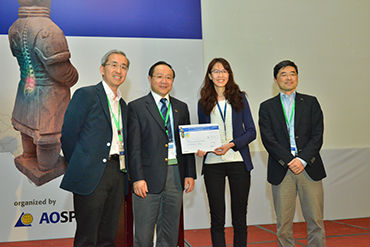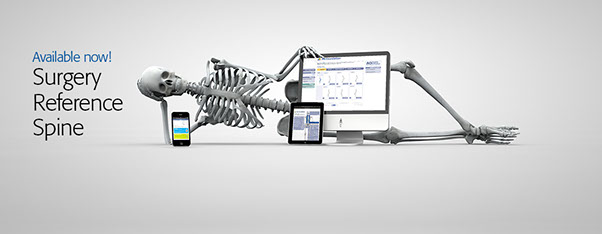AOSpine
Newsletter
1-2014
Content

"You see one, you do one, you teach one"
With the AOSpine research mentoring program in full-swing now, it was a pleasure to see the 6 mentees with their mentors at the World Forum for Spine Research in Xi'an. The young surgeons travelled from their respective homes in India, Nigeria, Indonesia, Pakistan, Argentina and the USA to come together for the first time at the WFSR where they received training on 'How to successfully set up your own clinical study in spine research'. This, along with further support and training from AO Clinical Investigation and Documentation (AOCID) will help the mentees and mentors to achieve the program's goal of submitting a research paper to a journal within one year.
As Daniel Riew, one of the key drivers of this project explains, high class research in AOSpine is successfully managed by the Knowledge Forums and the Spine Research Network, but on the other side of the spectrum, there are a lot dedicated members with little experience who are eager to learn how to conduct research. The mentoring program gives these young surgeons, often from areas where research has not been a big part, if any at all, of their formal education the chance to learn from someone with a high level of experience and work together on a research project. The mentors also find this to be a highly valuable and rewarding experience.
The program follows the motto "you see one, you do one, you teach one" with the view that each mentee will become a mentor for the next generation making access to research for all future surgeons more equal across the regions.
Watch this space for further updates on the success of the mentoring program.

WFSR success in China
On May 15–17, 2014, more than 200 registered participants among these many surgeons, engineers, scientists, veterinarians and invited speakers from 35 countries gathered in Xi'an, China to exchange knowledge on the recent advances on the intervertebral disc during the fourth edition of the World Forum for Spine Research (WFSR).
From the 214 abstracts submitted, 21 oral presentations, 26 short talks and 112 posters were presented during the three days making the forum a highly educational program where lively discussions emerged. Prizes were awarded to the best participants in each category.
This unique, international forum attracted clinicians and research scientists together to discuss intervertebral disc health at the basic, translational, and clinical research levels. Additionally, it offered a platform to foster new friendships and collaborations.
The pre-course tutorials presented an opportunity for participants to learn about the current surgical techniques of spine implants and to interact with some of the most renowned leaders in the field, such as K. Daniel Riew, Lisbet Haglund, Jeff Wang, Hongxun Sang, and many more.
The World Forum for Spine Research 2014 Chairpersons share their thoughts on what made the WFSR a success:
Prof. Zhuojing Luo (China): "In my eyes, the WFSR is an access to communicating with the world's top clinicians and researchers, a driving force of technical and theoretical innovation."
Prof. Kenneth Cheung (Hong Kong): " The WFSR has developed a cult following and a committed clientele that are excited by the breadth and depth of the science and surgery being discussed."
Prof. Keita Ito (the Netherlands): "The WFSR 2014 was again an opportunity for researchers and clinicians to come together to discuss the hottest developments pertaining to the intervertebral disc. By bringing it to China, we hope to have introduced a whole new audience to this exciting field."
AOSpine, organizer of the World Forum for Spine Research, would like to sincerely thank and congratulate the chairpersons, faculty, participants, and exhibitors for keeping the WFSR at the forefront of international spine care research.
We look forward to seeing you at the Global Spine Congress in Buenos Aires, Argentina in May 2015 and to the next combined Global Spine Congress and World Forum for Spine Research in Dubai, United Arab Emirates in 2016.
Lenke 1-6 Deformities – online AO Surgery Reference

Do you deal with patients suffering from a Lenke Deformities Type 1–6? Would you like to know more about the Lenke classification of deformities, the patient examination, and the selection of the fusion levels? If so, then the new AOSpine online referencing module is for you.
Larry Lenke and Kenneth Cheung would like to introduce you to the most comprehensive and practical online reference for colleagues exposed to deformity cases consisting of:
• Curve type (1–6)
• Lumbar spine modifier (A, B, C)
• Sagittal thoracic modifier (–, N, +)
The ease of access and the quality of information available make this tool unique and invaluable. It offers you everything you've ever needed, including:
• Diagnosis
• Decision
• Surgical approach
• Treatment
• Aftercare
Additional materials include: the insights on the Lenke classification; helpful information on patient examination; and helpful considerations when selecting the fusion levels. All this information is now available at your fingertips with clear illustrations. The AO Surgery Reference is consulted every day by over 4'300 of your colleagues, mainly in pre-operative planning. Get an insight and download the app like more than 120'000 others worldwide or use it online at www.aosurgery.org.
Keep a look out for the next module on spinal trauma which will be launched in December 2014.
AO Surgery Reference – stay tuned, stay focused!
AOSpine
www.aospine.org| membership@aospine.org
Copyright © 2014 AO Foundation. All rights reserved.
